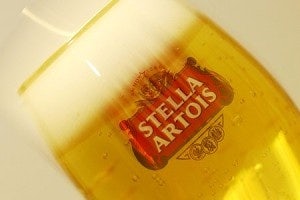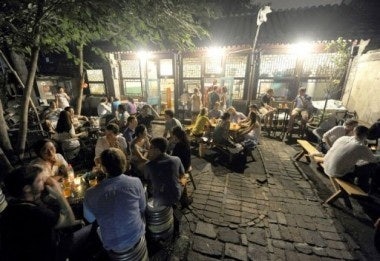Global Breweries Continue To Plow Into China Market, But Consumer Tastes Changing#

The world’s largest consumer of beer for nearly a decade, China’s thirst for beer, mostly German-style light lagers, has been well documented. As a producer, China also takes the top spot, with output of nearly 49 million kiloliters in 2011, a 9.3 percent increase over 2010 and the eighth year in a row of growth. But as living (and consumer) standards rise, domestic breweries have had to up their game to compete with the growing number of international brewers eying the country’s growing middle class. Over the past two decades, Chinese beer drinkers have become spoiled for choice, with international brands like Carlsberg and Heineken becoming ubiquitous nationwide and a growing number of beers in the premium (i.e., better quality, higher-priced) segment — both foreign and domestic — hitting bars and store shelves.
The premium beer segment in China is a broad one to say the least. As in the wine -- and "affordable luxury" -- market, brands that are very much mass-market in their countries often enter the China market positioning themselves as high-end, or at least, prestige names. So far, this strategy has worked very well for macro-brewers. Though smaller, craft breweries from Europe and the US are tapping the niche market for truly artisanal beer in a growing number of Chinese cities, aggressive expansion by mass-market brands like Heineken and Carlsberg have helped imported brands account for 70 percent of the premium beer market in China. Positioning their brands as more high-end is not only a way to drive sales, it's a pricing and profitability strategy. As Bloomberg noted late last year, premium lines enjoy around four times the profitability of low-end beer lines in China, and as Jing Daily previously pointed out, with their trademark low-range lines, Chinese brewers only see an average of 100 yuan (US$15) profit from one ton of beer. This market reality, and greater competition from foreign breweries, has pushed Chinese brands to experiment with higher-priced lines like Augerta and Yipin Pure by Tsingtao, and Zhujiang’s Supra White.
This week, China Daily profiled the country's premium beer industry, looking primarily at two international giants that have taken great pains to paint their brands as high-end in China: Carlsberg and Anheuser-Busch InBev. From the article:
[Carlsberg] owns more than 30 breweries in 11 provinces and autonomous regions, and in particular has been gaining a strong position in western regions of China since the early 2000s.
"Local brands and partners have helped establish a firm base for Carlsberg and provided better consumer insight," [Stephen Maher, chief executive officer of Carlsberg China] said, adding that his company intends to nurture people's loyalty to products by retaining local brands and flavors.
In addition, Belgium-based brewer Anheuser-Busch InBev launched in November began producing its high-end brand Stella Artois in China, said John Hsu, its president of BU North Business. The company also makes Beck's, Budweiser, Corona and Harbin in China.
Wang Renrong, vice-president in Asia-Pacific for AB InBev, said he believes the Chinese market will contribute 30 to 50 percent to the growth potential of the world's beer industry in the next few years.
He also said China has been one of AB InBev's most important markets, accounting for 12 to 13 percent of its total business. "We hope the figure will be bigger, as we see huge potential here," Wang added.
Stella Artois retails at 40 yuan for a 330-milliliter bottle in the market, while most beers are priced under 10 yuan.
...
"From the Chinese perspective, what we are trying to do is to say that beer has a role to play in Chinese celebrations," [Maher said].
Carlsberg has already had more than 20 brands targeting Chinese drinkers, although Maher conceded that companies need to get ahead of the trend if they want to make it big in the Middle Kingdom.
"The market has become more demanding, and the fast-changing landscape means that
the one with the ear closest to customer preference clearly walks away with the crown
," he added.
Talk of huge expansion and "tapping consumers' changing tastes" in China by mega-breweries like Carlsberg ignores one major fact about the China market: more affluent and adventurous beer drinkers in cities like Beijing and Shanghai have already made their first tentative steps away from German-style light lagers and towards low-production, independently made beer. Just as Chinese wine drinkers were until recently more or less content with mid-range domestic wines by the likes of Great Wall, tastes have rapidly shifted to French Bordeaux and (increasingly) Burgundy at the highest end, and to New World wines from Australia, the US and Chile among the middle class. While occupying the "premium" segment of China's beer industry will likely be very profitable for brewers like InBev and Carlsberg, as they have a brand perception head-start over Tsingtao and others, consumers who trade up-market won't stop at Heineken.

As Jing Daily wrote last December,
In Shanghai, Belgian-inspired beer bars like Kaiba are making fans of locals, and popular Chinese restaurants like Di Shui Dong are starting to carry a range of American and European craft beers alongside Budweiser and Tsingtao. The microbrewing scene in China is also starting to heat up, with the Boxing Cat Brewery in Shanghai and Beijing’s Great Leap Brewing and Slow Boat Brewery catering to lovers of hand-crafted beer.
While brands identified as "premium" by China Daily -- Carlsberg, Budweiser, Bud Light, Heineken and Skol -- may be able to convince the vast majority of drinkers in China that they truly are premium over the short term, this may not last forever. The rapidly changing consumer demand (and willingness to pay) for better ingredients and more choice means efforts by brands like Stella Artois to "re-debut" in China with reduced alcohol content (and the same price-tag) will likely lose a sizable proportion of the affluent, educated urban beer drinker demographic. In this way, the loss of mega-brewers could be the gain of China's burgeoning microbrewing scene. As Carl Setzer, the American co-founder and brewmaster of Beijing’s Great Leap Brewing, told Jing Daily last year:
I think that the approach to “localize” foreign brands to the Chinese market by gutting them and making them light and heartless is insulting to the growing Chinese craft beer drinking market, but at the same time its great for Great Leap Brewing, because it sets us apart from large industrial breweries who underestimate the potential of the market here. So as a consumer I think its horrible, but as a major contributor to the market I couldn’t be happier.

